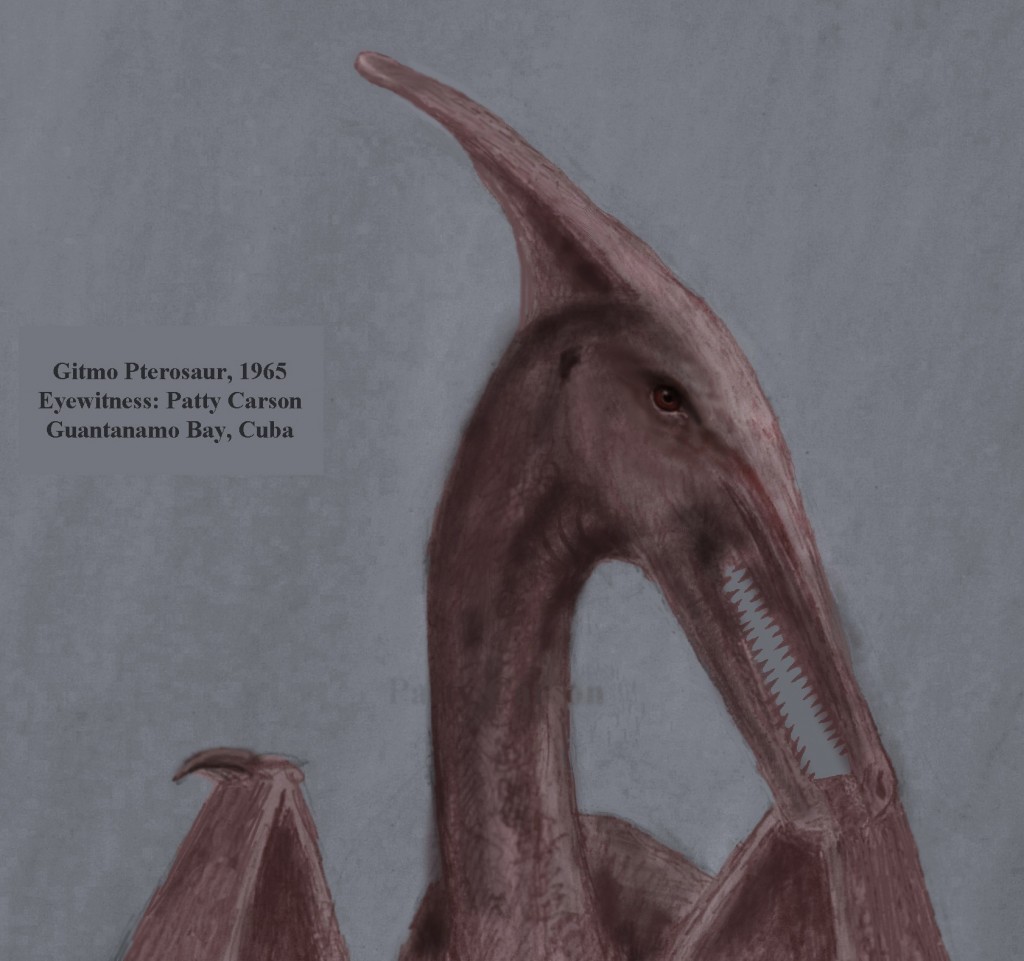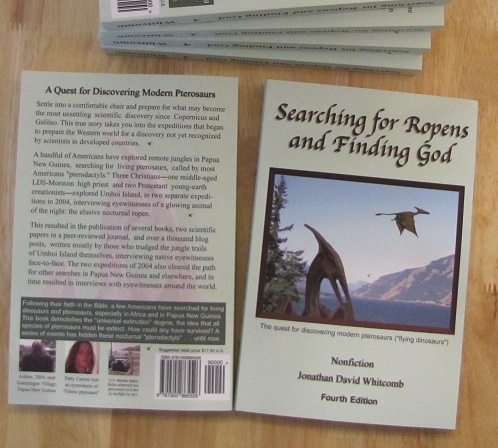The case of missing-child Garrett Bardsley has barely enough evidence to even mention in regard to potential attacks from a North American ropen. But even if only one child can be saved from being a victim, it will be worth all the efforts we can muster. Garrett may have simply become lost and succumbed to the weather, as many others have, over countless generations in countless mountain ranges; it’s not my place to speculate, as I have limited information at present. But this boy has a family and friends who have organized a foundation to help other children in need. That spirit of service deserves attention.
The Garrett Bardsley Foundation – for Rescuing
Who could ask more from any organization, for the more-conventional reasons a child could go missing in or near a wilderness area? More volunteers, better-qualified and arriving at the location quicker—those make it more likely that a lost child may be found faster. I applaud the efforts of all those who have become involved in this noble effort to find missing persons.
I highly recommend that people become involved in this mission of the Garrett Bardsley Foundation. New volunteers are welcome, surely.
The child Garrett Bardsley
It was only one sock in a field of boulders, and that’s not enough for me to speculate. I mention it here because other missing persons have items of clothing and shoes that are found away from where the living person or body was found, and some of those cases have more circumstantial evidence that a large ropen may have been responsible for the living person or body to be so far from where the person became missing. For those unaware of the Bardsley case, please see online resources or the book Missing 411 Western United States & Canada, by David Paulides.
Please be aware that the ideas present here are based upon preliminary information that I have received and are my own ideas, not those of the nonfiction author David Paulides.
Of the thousands of missing-persons cases investigated by Paulides, Garrett’s case was given three pages in his book; the following is from what I have learned from it.
He and his father were with other members of a Boy Scout camp at Cuberant Lake in the Uinta Mountains of Utah, on August 20, 2004, the day this boy disappeared. My heart goes out to each family member and friend.
Garrett and his father were fishing at the lake when the boy slipped and got his shoes and pants wet. He later walked back towards the camp to change his socks. This does suggest to me that the sock later found in the boulder field may have been there in relation to those circumstances. Without that account of the wet socks, the case would appear too similar to other cases to ignore, cases in which a person, body, or clothing/shoes were found in a boulder field or elsewhere, suggesting a ropen attack. I’m still too ignorant of the Bardsley case to speculate on it, so let’s move on.
The First Umboi Island Ropen Expedition of the Year 2004
How has my research related to missing-persons cases? This is complicated, so I’ll summarize.
In the final few weeks of preparation for my expedition in 2004, I knew nothing about this boy who went missing in the Uinta Mountains, and if I had read anything about it I would not have made the connection at that time. I arrived in Papua New Guinea in September of that year, knowing of occasional attacks on children and adults in remote tropical wildernesses of the southwest Pacific; but those apparently rare attacks related to my investigation only indirectly, or so I thought in 2004.
On Umboi Island, Papua New Guinea, I interviewed many native eyewitnesses, most of whom saw the ropen only at a distance at night. Michael, an old man in Opai Village, told me about a grave robbery in Gomlongon Village, decades earlier, but none of the natives I questioned in my two weeks on that island reported any first-hand account of an attack on a living human.
The ropen uses intrinsic bioluminescence to feed on clams and possibly fish, on the reefs that surround Umboi Island. Others of that species of flying creature apparently visit this island, probably temporarily, for breeding or to challenge the territory of this one large ropen. This kind of flying creature, at least in this species, may do some scavenging at night, but the main diet is probably what it catches on the reefs.
I learned of one missing-person case during my two weeks on Umboi Island, but it involved circumstantial evidence at best. An old lady, reportedly insane, said that she was going to look for the ropen. She left her village and was never seen again. I’ll not speculate on that; who knows?
I interviewed three of the seven eyewitnesses of the 1994-Lake-Pung flyover. Those three young men were highly credible in my opinion. They ran home in terror, after seeing the ropen fly over the surface of a crater lake at mid-day, about ten years before our interview. One of those three men still appeared to show signs of fear in answering my questions about the encounter (Mesa).
Human fear of an animal is not evidence that a particular ropen would attack a person, of course, but the size of this one explains the terror felt by those seven men, who were only boys or teenagers at the time.
Gideon Koro gave me his estimate for the length of the tail of this ropen: seven meters (23 feet). This could appear unbelievable to many Americans, except that some Australians and one American have seen similar flying creatures in the southwest Pacific, and some of their estimates for size are not that far afield from Gideon’s.
A few weeks after my return to the United States, two other American cryptozoologists explored Umboi Island in the second expedition of 2004. Their detailed interviews and observations confirmed my own conclusions: The ropen is a real animal, normally seen at night because of its bioluminescence, but definitely a long-tailed flying creature, as a few natives have seen it close enough to see not only the glow but some of the features, including the long tail.
Investigation by Jonathan Whitcomb
Over the past eleven years, I have devoted over 10,000 hours to this investigation of reports of apparent living pterosaurs. That does not prove that I have been perfectly objective, but we are all human, with various potential biases. The point is this: I have tried to see and understand various points of view, but I have probably spent more time in this narrow branch of cryptozoology than any other person on earth, during these past eleven years, and some of what I have learned deserves attention regarding a small fraction of the cases of human disappearances. Most missing persons surely can have their disappearances reasonably explained in conventional ways, but not all of them.
On this subject of modern pterosaurs I have written three non-fiction books, one scientific paper in a peer-reviewed journal of science, and over a thousand online posts and web pages. I can only summarize here.
The official discovery of extant species of pterosaurs, by Western scientists, has been delayed for several reasons. It’s not just that they are uncommon flying creatures or that they are somehow confined to remote tropical jungles (they are not) or that they are mostly nocturnal. Westerners like Americans, Australians, Canadians, and many others, are indoctrinated into the concept that I call universal extinctions.
I do not dispute the extinctions of many species of pterosaurs, in their extraordinary varieties of head crests and other characteristics, known from fossils. But I proclaim the critical difference between universal extinction and near-extinction, for general types like dinosaur and pterosaur. I know that a few species of pterosaurs are still living in various areas of the planet, yet most of them are of a narrow range of characteristics: horn-like pointed head crest and long tail especially.
Numerous credible eyewitness from around the world, from various languages, various cultures, and various religious beliefs—they have seen the same basic type of featherless flying creature: an apparent Rhamphorhynchoid pterosaur. A small percentage of these non-bats grow to be quite large, sometimes larger than any bird classified by Western science. You don’t need to believe in the Genesis account of the Flood of Noah to see one of these flying creatures. You just need to be lucky enough (or unlucky) to be at a particular place at a particular time when you are looking in the right direction.

Sketch by Patty Carson: the large flying creature she saw when she was a child in Cuba
.
Attacks in Canada and in Mexico
This must be greatly summarized here: Investigators other than myself have reported attacks on people in Mexico and in Canada. I have communicated with some of those who have interviewed victims or near-victims, and I believe that these are actual cases of attack. Now, why would Americans in wilderness areas of the United States be immune to attacks from these large flying creatures, if it happens in Mexico and in Canada?
Please be aware that the great majority of these flying creatures may never in their lives attack any human. Some appear to feed on fish or bats or birds, in various areas. It is only a few individuals among these uncommon animals, only a few, that attack people, and then mostly when a person is alone in a wilderness. These are rare cases compared with those many people who go missing because of simply becoming lost or a child being taken away by a non-custodial parent (or some other adult).
Attack on an Animal Prey
The ropen is only one type of modern pterosaur, but it is less rare than the other type, so we’ll now confine ourselves to this long-tailed flying creature. In at least one species, it has a way to subdue prey without greatly risking personal injury. The wings of the ropen are probably delicate enough to require the following.
From two sources, I have learned that, in at least one species, this predator has the capacity to emit a mist or vapor that is harmful or disabling to an animal or person who inhales it. The two researchers with whom I have communicated appear to have had no prior connections, so I consider their investigations to have been truly independent confirmations of this concept. One of them is the nonfiction author Gerald McIsaac of British Columbia, Canada.
At night, this emission can appear like a puff of smoke, but I’ll call it vapor. The concept is this: The ropen surprises an animal at night, flying close enough to emit the vapor into the prey’s face. If the vapor appears to have the desired effect, the ropen will then carry the prey away. This emission of a vapor has been witnessed in British Columbia and written about by McIsaac in his book Bird From Hell.
Missing Clothing and/or Shoes
If a large ropen attacks a human, one difference is critical: People wear clothing and shoes. That means the predator may sometimes grasp mostly a shoe or a coat or other article of clothing. Over a significant flying distance, the person may fall out of the clothing or shoe, leaving the flying predator with only that item or items, at least for a short flying distance.
Remember, humans are surely not the normal prey, so clothing is not accounted for, by the predators, in these attacks. When the animal realizes what has happened, it may fly back to look for the person. Sometimes that person may again be carried off; sometimes a ropen fails to locate the victim which sometimes allows human rescuers to later find a living person or body.
In any event, this kind of attack may result in strange pieces of clothing or shoes being missing from a found person or body, or found somewhere else. This does not mean that all cases in which clothing or shoes are missing is best explained by this kind of animal attack, but some cases appear to suggest this.
I wonder how much law enforcement knows about this concept.
The following sentence is taken from the online article “Searchers find 14-year-old Utah boy missing for four days alive” published by the Salt Lake Tribune on August 4, 2013:
The sheriff’s office had said it thought Duran would be barefoot and without a coat in the forest near 10,000 feet elevation, but the office did not disclose whether that turned out to be correct or disclose other details of Duran’s discovery on Sunday.
The Strange Case of Mike McDonald
How can any American explain the following case of a missing two-year-old who was found almost perfectly healthy? With no knowledge of these large flying creatures, this report could have baffled even a detective like Sherlock Holmes.
The two-year-old disappeared from his yard in Sulphur Springs Valley, Arizona, on October 30, 1945, and also missing was the family dog. Many people searched for the boy, with no success until the following day. This is where things get strange.
The little boy was found 15 miles away, sleeping in a little cave, and nearby was the family dog, perhaps standing guard over the two-foot-wide entrance to the cave. The only injury to the two-year-old Mike was a small cut on one foot. Consider the standard explanations:
- Predator like a mountain lion
- Predator like a bear
- Wandering child
- Kidnapping by a human
The first two make no sense for child who is found almost perfectly uninjured and 15 miles from where he went missing. A mountain lion is only slightly less unbelievable than a bear, but the long distance involved makes it practically impossible to move a human without additional injuries.
A two-year-old human does not wander fifteen miles from home within one day. Even if Mike could have covered that distance, how would he have known where to find a cave to shelter his little body? The two men who found him knew nothing about that cave until they saw the family dog there, apparently protecting little Mike.
How could a human kidnapper be heartless enough to steal away that precious little one and yet have the heart to put him in a sheltering cave and then again be heartless enough to leave him there to die? Kidnappers don’t usually have so many changes of heart within twenty-four hours. And why allow the family dog to follow along and then remain to stand guard over the cave entrance? In addition, if a human kidnapped that child, how easy it might have been for trackers to follow his trail! Tracking did not find the child, but good fortune did.
Explaining the McDonald Case
As best as I can make it out for now, here is probably what happened:
A medium-sized ropen surprised the child, subduing him with vapor enough that he did not cry out. Dog barking may have been normal during play time, so the mother took little notice of this particular barking. To avoid exerting unnecessary energy, the ropen acted as it normally did when carrying away a prey animal, flying no higher than was necessary. This allowed the dog to follow along, not necessarily close behind but within sight.
When the ropen arrived at its little cave, it made an unpleasant discovery. That dog was catching up, soon to be upon him. The ropen left the boy in the cave and flew up into the air, just out of reach of the guardian. Nothing that average-sized ropen could do would discourage the dog. Every time the predator would swoop down to deliver a dose of vapor, the dog would run away at full speed (dogs are not stupid). The ropen could not enter the cave without risk of getting bitten, so it eventually gave up. It flew away to find a better hiding place, leaving the family dog to stand guard over the cave entrance.
Mike was fortunate to have only one small cut on one foot. Many other victims have been found badly scratched, sometimes no longer living (although death is often more likely to have come from exposure than from a fall or from scratches). In this case, a ropen may have been holding mostly clothing and the clothing was holding onto the child, fortunate indeed. I believe the vapor had an affect. Perhaps it was a normal sleep for that two-year-old, when he was found; I’m not so sure it was a normal sleep.

Jonathan and Gladys Whitcomb at Ensign Peak, Salt Lake City, Utah, 2014
###
.
Missing Persons and Flying Creatures
I’m only beginning to learn about missing-person mysteries in the United States, having received two books in the mail only yesterday: “Missing 411 Western United States & Canada” and the more-recently published “Missing 411 The Devil’s in the Detail,” both by the investigative journalist David Paulides.
Nick and a co-worker of mine both put the story of Garrett Bardsley back in my head, independent of one another. I’d covered the story when it originally happened and it, along with the deaths of Carole Weatherton and Kim Beverly, are two great mysteries of the area.
. . . aren’t fossil experts supposed to write about fossils? Is not the favorite subject of conversation, for a paleontologist, the remains of ancient, primitive dinosaurs and pterosaurs? That’s what I thought, until last month.
American Cryptozoologist Jonathan Whitcomb
Within days of Paul Nation’s return to the United States, Whitcomb flew to Texas and interviewed the cryptozoologist, then returned to California with what may have been the first substantial physical evidence, ever brought back to the United States, for the bioluminescence of large flying creatures that may be living pterosaurs.
.
Quest for discovering modern pterosaurs: Searching for Ropens and Finding God
From the title page in this nonfiction paperback:
This overshadows common true-life adventures, revealing the early stages of what may become the most unsettling scientific discovery since Galileo and Copernicus. It soars above disputes about religion, revealing why an official discovery of an extraordinary animal was delayed for so long. Above all, this explores human experiences—of eyewitnesses and those who interviewed them.
.







